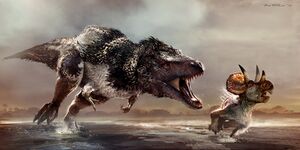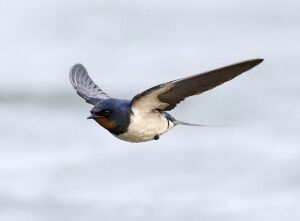Dinosaur: Difference between revisions
1d4chan>Thannak No edit summary |
1d4chan>Sombraptor No edit summary |
||
| Line 1: | Line 1: | ||
[[Image:Tyrannosaurus.jpg|thumb|A Tyrannosaurus | [[Image:Tyrannosaurus.jpg|thumb|A ''Tyrannosaurus rex''!]] | ||
'''Dinosaurs''' are a category of creatures of the | '''Dinosaurs''' are a category of creatures of the clade Dinosauria, which first emerged around 250 Million Years ago in the Triassic period. Generally these creatures have been classified as reptiles, with their name itself meaning "terrible" (dino) "lizard" (saurs), since their discovery and cataloging by modern science. | ||
However due to recent discoveries, [[Skub|it created a large divide | However due to recent discoveries, [[Skub|it created a large divide in the Paleontology community on whether they should still be classified as inherently reptile or something completely new.]] | ||
Dinosaurs came to be the dominant form of large, | Dinosaurs came to be the dominant form of large, scaly, land dwelling life forms across all of earth's major continents through the Jurassic and Cretaceous period. Dinosaurs were, and are, the biggest animals ever to live on land, [[Skub|however what counts as THE biggest is often up in debate by the scientific community,]] as this [[RAGE|usually this ends in flamewars between Sauropod-Fanboys and Cetacean-Fanboys]] (yes, they do exist, kind of like the relationship between [[Star Wars]] fanboys and [[Star Trek]] fanboys), but the more neutral term is Sauropods=Land and Whales=Ocean. | ||
They are regarded as [[Fist of the North Star|awesome]] for several reasons.... | They are regarded as [[Fist of the North Star|awesome]] for several reasons.... | ||
*They appeal to the sensational because they're "monsters", but unlike most they actually | *They appeal to the sensational because they're "monsters", but unlike most, they actually DID exist. | ||
*It's also been postulated that dinosaurs were the inspiration for [[Dragon|dragons]] with people discovering dinosaur bones and making up stories about them, though that is debatable. | *It's also been postulated that dinosaurs were the inspiration for [[Dragon|dragons]] with people discovering dinosaur bones and making up stories about them, though that is debatable. | ||
*Some of the largest | *Some of the largest dinosaurs were larger (as in '''much''' larger) then the largest living land mammal, the African Elephant. In fact, the ''Paraceratherium orgosensis'' (a relative to the direct ancestor to the modern Rhinoceros) which was the largest land mammal to have ever existed on Earth, would be classified as "small-Sized" by sauropod standards. | ||
*The largest | *The largest sauropods are big enough that they can be classified as [[Godzilla|"Kaiju-Size"]] and could furthermore cause mini-earthquakes and create sonic booms with their tails. | ||
*A popular idea is if the | *A popular idea is if the asteroid did not hit Earth, then it would be the [[Lizardmen|''Troodon'']] (arguably the most intelligent non-avian dinosaur, which resembled ''Velociraptor'', with extremely birdlike characteristics) that would be building civilizations and spaceships rather than humans. | ||
[[Tl;dr|Tl;dr,]] Dinosaurs are '''NOT''' to be fucked with. | [[Tl;dr|Tl;dr,]] Dinosaurs are '''NOT''' to be fucked with. | ||
[[Image:Dinosaur.jpg|thumb|left|A modern day | [[Image:Dinosaur.jpg|thumb|left|A modern day dinosaur of the theropod lineage]] | ||
Most lines of dinosaur were extinguished during the Cretaceous–Paleogene Extinction Event some 65 million years ago. The only surviving branch of this clade are birds, which | Most lines of dinosaur were extinguished during the Cretaceous–Paleogene Extinction Event some 65 million years ago. The only surviving branch of this clade are birds, which almost all scientists actually do consider dinosaurs (that's right, its fair to say that all birds everywhere are living dinosaurs). | ||
The other close surviving relatives of dinosaurs are the crocodiles, a different branch of the archosaur family that carries on its traditions of eating whatever they want and [[Lizardfolk|giving no fucks about mammals]] Contrary to popular belief, the Komodo dragon, a species of monitor lizard, was ''not'' related to the dinosaurs. It is, however, somewhat closely related to creatures commonly mistaken for dinosaurs - Mosasaurs. The dragon is notable for carrying [[Nurgle|Jurassic period bacteria]] so virulent that a single bite can fatally infect other animals. | |||
== Things people think are dinosaurs, but are not: == | |||
*Pterosaurs: These flying archosaurs had among their ranks the largest flying creatures that ever lived and were the closest clade to dinosaurs, but are ''not'' actually dinosaurs. | |||
*Marine Reptiles: During the Mesozoic era there were a variety of large marine reptiles, including Icythosaurs, Plesiosaurs, Mosasaurs and various other beasties. As these creatures are big, reptillian, and look like dinosaurs, the general public often lumps them in as dinosaurs. In truth these are a number of separate families that took to the sea. | |||
*Synapsids: Before the dinosaurs really took off as the dominant form of life during the Triassic period the Synapsids, sometimes known as "mammal-like reptiles" were king. One member of this clade is ''Dimetrodon'' or "that fin-back lizard thing' in the Land Before Time and those sets of dinosaur toys your mom bought you when you were a kid". You can tell they're not dinosaurs (and this is a very loose definition) thanks to an extra opening in the skull behind the eye where jaw muscles attached and later became the Sphenoid bone which sits behind the eyes, specialized teeth including canine teeth, a smaller jaw which consists of only a single bone connected near the ear in a depression in the greater skull called the glenoid cavity, a secondary palate which separates the mouth and nasal cavities and gradually became a full bone, a gradual increase in metabolism efficiency until they became warm-blooded, and a thick dermal layer consisting of hair, skin, scale plates, and bony armor, and whiskers. As the name suggests these guys became the early mammals which turned into us. Its unknown at what point they began to give birth to live young and lactate, although since fur was an extremely late adaptation its generally thought there was a point where something that appeared to be a dinosaur had lizard<strike>tits</strike>teats. | |||
{{Stub}} | {{Stub}} | ||
[[Category:Monsters]] | [[Category:Monsters]] | ||
Revision as of 20:56, 2 March 2016

Dinosaurs are a category of creatures of the clade Dinosauria, which first emerged around 250 Million Years ago in the Triassic period. Generally these creatures have been classified as reptiles, with their name itself meaning "terrible" (dino) "lizard" (saurs), since their discovery and cataloging by modern science. However due to recent discoveries, it created a large divide in the Paleontology community on whether they should still be classified as inherently reptile or something completely new.
Dinosaurs came to be the dominant form of large, scaly, land dwelling life forms across all of earth's major continents through the Jurassic and Cretaceous period. Dinosaurs were, and are, the biggest animals ever to live on land, however what counts as THE biggest is often up in debate by the scientific community, as this usually this ends in flamewars between Sauropod-Fanboys and Cetacean-Fanboys (yes, they do exist, kind of like the relationship between Star Wars fanboys and Star Trek fanboys), but the more neutral term is Sauropods=Land and Whales=Ocean.
They are regarded as awesome for several reasons....
- They appeal to the sensational because they're "monsters", but unlike most, they actually DID exist.
- It's also been postulated that dinosaurs were the inspiration for dragons with people discovering dinosaur bones and making up stories about them, though that is debatable.
- Some of the largest dinosaurs were larger (as in much larger) then the largest living land mammal, the African Elephant. In fact, the Paraceratherium orgosensis (a relative to the direct ancestor to the modern Rhinoceros) which was the largest land mammal to have ever existed on Earth, would be classified as "small-Sized" by sauropod standards.
- The largest sauropods are big enough that they can be classified as "Kaiju-Size" and could furthermore cause mini-earthquakes and create sonic booms with their tails.
- A popular idea is if the asteroid did not hit Earth, then it would be the Troodon (arguably the most intelligent non-avian dinosaur, which resembled Velociraptor, with extremely birdlike characteristics) that would be building civilizations and spaceships rather than humans.
Tl;dr, Dinosaurs are NOT to be fucked with.

Most lines of dinosaur were extinguished during the Cretaceous–Paleogene Extinction Event some 65 million years ago. The only surviving branch of this clade are birds, which almost all scientists actually do consider dinosaurs (that's right, its fair to say that all birds everywhere are living dinosaurs). The other close surviving relatives of dinosaurs are the crocodiles, a different branch of the archosaur family that carries on its traditions of eating whatever they want and giving no fucks about mammals Contrary to popular belief, the Komodo dragon, a species of monitor lizard, was not related to the dinosaurs. It is, however, somewhat closely related to creatures commonly mistaken for dinosaurs - Mosasaurs. The dragon is notable for carrying Jurassic period bacteria so virulent that a single bite can fatally infect other animals.
Things people think are dinosaurs, but are not:
- Pterosaurs: These flying archosaurs had among their ranks the largest flying creatures that ever lived and were the closest clade to dinosaurs, but are not actually dinosaurs.
- Marine Reptiles: During the Mesozoic era there were a variety of large marine reptiles, including Icythosaurs, Plesiosaurs, Mosasaurs and various other beasties. As these creatures are big, reptillian, and look like dinosaurs, the general public often lumps them in as dinosaurs. In truth these are a number of separate families that took to the sea.
- Synapsids: Before the dinosaurs really took off as the dominant form of life during the Triassic period the Synapsids, sometimes known as "mammal-like reptiles" were king. One member of this clade is Dimetrodon or "that fin-back lizard thing' in the Land Before Time and those sets of dinosaur toys your mom bought you when you were a kid". You can tell they're not dinosaurs (and this is a very loose definition) thanks to an extra opening in the skull behind the eye where jaw muscles attached and later became the Sphenoid bone which sits behind the eyes, specialized teeth including canine teeth, a smaller jaw which consists of only a single bone connected near the ear in a depression in the greater skull called the glenoid cavity, a secondary palate which separates the mouth and nasal cavities and gradually became a full bone, a gradual increase in metabolism efficiency until they became warm-blooded, and a thick dermal layer consisting of hair, skin, scale plates, and bony armor, and whiskers. As the name suggests these guys became the early mammals which turned into us. Its unknown at what point they began to give birth to live young and lactate, although since fur was an extremely late adaptation its generally thought there was a point where something that appeared to be a dinosaur had lizard
titsteats.